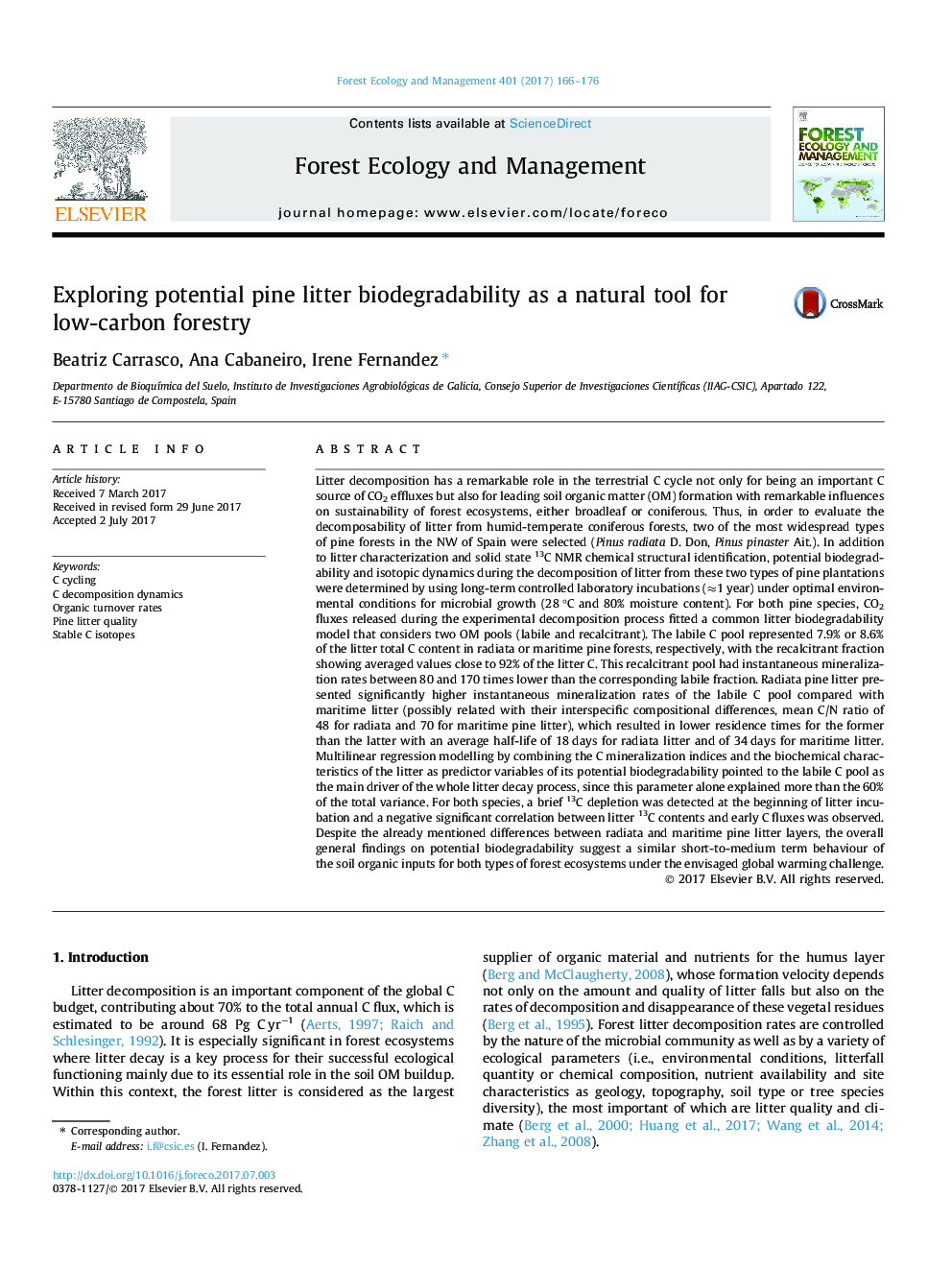| کد مقاله | کد نشریه | سال انتشار | مقاله انگلیسی | نسخه تمام متن |
|---|---|---|---|---|
| 4759311 | 1421357 | 2017 | 11 صفحه PDF | دانلود رایگان |
عنوان انگلیسی مقاله ISI
Exploring potential pine litter biodegradability as a natural tool for low-carbon forestry
ترجمه فارسی عنوان
بررسی قابلیت تجزیه بیولوژیکی خاک بستر کاج به عنوان یک ابزار طبیعی برای جنگلداری کم کربن
دانلود مقاله + سفارش ترجمه
دانلود مقاله ISI انگلیسی
رایگان برای ایرانیان
کلمات کلیدی
موضوعات مرتبط
علوم زیستی و بیوفناوری
علوم کشاورزی و بیولوژیک
بوم شناسی، تکامل، رفتار و سامانه شناسی
چکیده انگلیسی
Litter decomposition has a remarkable role in the terrestrial C cycle not only for being an important C source of CO2 effluxes but also for leading soil organic matter (OM) formation with remarkable influences on sustainability of forest ecosystems, either broadleaf or coniferous. Thus, in order to evaluate the decomposability of litter from humid-temperate coniferous forests, two of the most widespread types of pine forests in the NW of Spain were selected (Pinus radiata D. Don, Pinus pinaster Ait.). In addition to litter characterization and solid state 13C NMR chemical structural identification, potential biodegradability and isotopic dynamics during the decomposition of litter from these two types of pine plantations were determined by using long-term controlled laboratory incubations (â1 year) under optimal environmental conditions for microbial growth (28 °C and 80% moisture content). For both pine species, CO2 fluxes released during the experimental decomposition process fitted a common litter biodegradability model that considers two OM pools (labile and recalcitrant). The labile C pool represented 7.9% or 8.6% of the litter total C content in radiata or maritime pine forests, respectively, with the recalcitrant fraction showing averaged values close to 92% of the litter C. This recalcitrant pool had instantaneous mineralization rates between 80 and 170 times lower than the corresponding labile fraction. Radiata pine litter presented significantly higher instantaneous mineralization rates of the labile C pool compared with maritime litter (possibly related with their interspecific compositional differences, mean C/N ratio of 48 for radiata and 70 for maritime pine litter), which resulted in lower residence times for the former than the latter with an average half-life of 18 days for radiata litter and of 34 days for maritime litter. Multilinear regression modelling by combining the C mineralization indices and the biochemical characteristics of the litter as predictor variables of its potential biodegradability pointed to the labile C pool as the main driver of the whole litter decay process, since this parameter alone explained more than the 60% of the total variance. For both species, a brief 13C depletion was detected at the beginning of litter incubation and a negative significant correlation between litter 13C contents and early C fluxes was observed. Despite the already mentioned differences between radiata and maritime pine litter layers, the overall general findings on potential biodegradability suggest a similar short-to-medium term behaviour of the soil organic inputs for both types of forest ecosystems under the envisaged global warming challenge.
ناشر
Database: Elsevier - ScienceDirect (ساینس دایرکت)
Journal: Forest Ecology and Management - Volume 401, 1 October 2017, Pages 166-176
Journal: Forest Ecology and Management - Volume 401, 1 October 2017, Pages 166-176
نویسندگان
Beatriz Carrasco, Ana Cabaneiro, Irene Fernandez,
